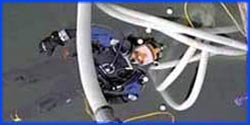


Premier Date: June 1, 2011
busted
Adam and Jamie called in a U.S. Army sniper for some preliminary tests to measure the time it took for a bullet to reach its target. After some failed attempts, they obtained travel times of 231, 597, and 1791 ms for distances of 200, 500, and 1,200 yd (180, 460, and 1,100 m), respectively. Next, the pair did some workshop tests to find how quickly they could dodge a shot, using a camera flash to simulate the muzzle flash. Jamie proved slightly faster, dodging in 490 ms; based on this result, he and Adam calculated that the shooter would have to be at least 400 yd (366 m) away.
They then watched Dave fire standard blank cartridges from various distances and found that they could not see his muzzle flash at all past 200 yd (183 m). When he switched to Hollywood-style blanks with much heavier gunpowder loads, they could easily see the flash out to 1,200 yd (1,097 m). Finally, they set up a blank-firing rifle at 200 yards, wired to a timer and paintball gun; when one man pulled the trigger, a paintball would be fired directly at the other’s chest after 231 ms. Neither was able to dodge any shots until the rifle was moved to 500 yd (457 m) (600 ms delay) and loaded with Hollywood blanks. Adam and Jamie declared the myth busted, since an actual sniper would take precautions to ensure that the target would not see the muzzle flash.
busted
The Build Team fitted Buster with accelerometers, hauled him up with a construction crane, and dropped him feet-first onto pavement and water. Drops from 25 ft (8 m) gave g-force measurements of 60 g on pavement, but less than 25 g on water (the lower threshold that the instruments could measure). At 75 ft (23 m), the team obtained a reading of 29 g for water, but over 500 g for pavement (the upper measuring limit). To investigate the effect of body orientation on impact forces, the team did more drops with Buster in a belly-flop position. Pavement and water drops from 25 ft (8 m) gave 286 g and 115 g, respectively, while 50 ft (15 m) drops maxed out the instrument on pavement and registered 220 g on water.
For a final test at terminal velocity (roughly 120 miles per hour), Tory threw two pig carcasses out of a helicopter at 600 ft (183 m), after which they were X-rayed to determine injuries. The pavement drop resulted in 17 fractures, a shattered pelvis, and a decapitation, while the water drop yielded 7 fractures and a broken neck. Since no water landing produced the same level of impact force or injury as a fall from the same height onto pavement, the team declared the myth busted.
Previous: Episode 166: Spy Car 2